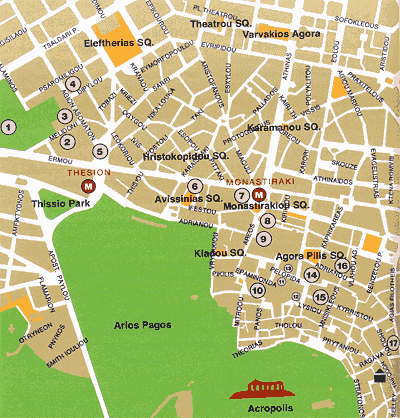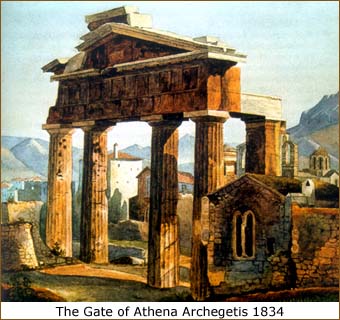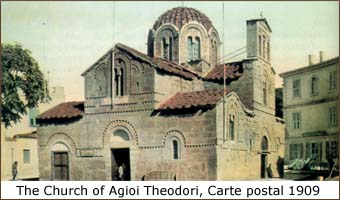|
Special Feature:
Heritage Walks in Athens |
|
4th Heritage Walk:
The City Center from Antiquity to the Ottoman Period |
 (Continued from
May's Issue) (Continued from
May's Issue)
STARTING POINT: Thisio Station
TERMINUS:
Acropolis Station
The 4th walk takes us through all the centuries of
the Athenian past; including those in which the city
had been seriously
diminished in size and had lost its allure for the
outside world. The visitor will enjoy some fine
views and also
masterpieces of art and architecture.
-
(1) KERAMEIKOS: The official cemetery of ancient
Athens from the 11th century BC until the 2nd
century AD. The region received its name from the
existence in the vicinity of many pottery or ceramic
workshops. The walls of ancient Athens: One can
still see the "lithologimata",
three consecutive rows of stones that date from the
classical times.
Kerameikos Gates:Holy Gate:Dipylon: The Kerameikos
Gates are the name of the official entrances to
ancient Athens at
this point. These gates divided the area into the
inner and outer Kerameikos, where the tombs were
placed. From the Holy
Gate began the lera Odos, or Sacred Road, which led
to the Shrine of Demeter in Eleusis. From the
Dipylon Gate would begin
the procession in the direction of the Acropolis
during the Great Panethenaic Festival.
The Dipylon was the largest gate of the ancient
Greek world, its large size being useful for
strategic and religious
reasons alike. Outside the Dipylon began the road of
Kerameikos, commencing in a square for ceremonies
(gatherings,
sacrifices and athletic competitions) in honour of
the dead who were being buried in the nearby Public
Memorial.
Street of the Kerameikos: Just outside the Dipylon
gate began the imposing Street of the Kerameikos,
the so-called "Road
to the Academy" that led to the most beautiful of
the suburbs. It was here that Plato founded his
school. The street was
39m wide and 1.5 km long, and along the sides of the
road there were graves of prominent Athenians. On
the left of the
ancient Street of the Kerameikos, one could see the
brightest of all monuments, the Public Memorial or "Polyandreion"
that
contained the graves of those Athenians that had
died in war, who were cremated at public cost.
According to Thucydides,
it was here Pericles made his famous "Epitaphios"
speech, to honor the first victims of the
Peloponnesian War.
In inner Kerameikos, on the inner side of the wall,
stood the Pompeion, a structure used for the
preparation of festival
processions, built in three phases (400 BC; 2nd
century AD; and 4th century AD). At the entrance
stood an impressive propylon, and in front of it, a spacious plaza.
Every four years, the Panathenaic procession began
here.
Kerameikos Museum: It holds a large and varied
collection of burial vessels that date from the 11th
century BC (Sub-Mycenaean period) until the 2nd century AD (Roman
era), and grave gifts of various periods. An
indicative list includes an
iron sword, the oldest found on Greece (1025 BC);
unique archaic pots bearing designs of roosters,
lotus flowers, and
mourners of the ancient period; lekythi, a type of
pot used to contain perfume for the departed; a
small lead box; a
statuette bearing an inscription with curses of c.
400 BC, a case of sympathetic magic; archaic marble
tomb plaques
bearing moving inscriptions; and the burial stele of
Dexileos (394-393 BC). Special mention should be
made of the recently
discovered Kouros (male figure) of the Sacred Gate
(c. 600 BC), a great work that is thought to be the
work of "the master
sculptor of the Dipylon Gate".
-
(2)
THE JEWISH SYNAGOGUE: The Beth Shalom Synagogue
was built in 1935. The Romaniote Synagogue, exactly
facing the former, was built in 1904 and is still in
function but only on the major Jewish holidays.
There is evidence supporting the presence of Jews in
Athens since as early as the 3rd century BC. The
first ever Synagogue in Athens is thought to have
been housed in one of the buildings found within the
boundary of the ancient agora.

-
(3)
MUSEUM OF TRADITIONAL POTTERY: An interesting
Museum displaying modern Greek ceramics, with
representative pieces of
work made in workshops from all over Greece, and a
large collection of vessels. It is housed in a
19th century neoclassical
building.
-
(4) BENAKI MUSEUM OF ISLAMIC ART: Antonis Benakis
lived in Alexandria and was one of the first
collectors of Islamic works
of art. His collection includes 10,000 pieces
covering 13 centuries of artistic creation, and is
considered one of the
best of its kind in the world. The exhibits are on
display in a fine neoclassical building, recently
restored.
In the basement of the Museum lies one of the best
preserved parts of the ancient city walls.
The collection is exhibited in four halls and the
works date from all periods of Islamic art. They
include:
A wood-carved door from Baghdad (8" century), a
splendid piece of the late Ommayad period {No.
9121}.
A wood-craved door from Takrit (9th century), a
marvelous piece of Abbasid art {No. 9128). • An Egyptian Fatimid plate (10th -11th century), made
with metal colors, signed by the artist Muslim {No.
193761.
• A Carpet from Tiberias (10th century), made of
natural fibers, decorated with Kufic inscriptions
{No. 147351.
• A bronze astrolabe by the astronomer Ibn Al-Sarraj,
from Aleppo (1328-1329) {No. 13178}.
• A ceramic egg from Iznik (Nicaea), of the 16th
century, which was once part of the "Dome of the
Rock" mosque in
Jerusalem {No. 9}.
• A Calligrapher's box of 1587 for collecting
penholders, containing ivory inset, signed by
Muhammad Munshi Ghaznavi
from Gujarat {No. 10181}.
• Golden Qajar jewels (18th-19th century) from
Persia. A unique collection alike for quality and
quantity with a total of
224 pieces. (No. 21549217721.
(cnr Dipylou and Asomaton Sts, tel.: 210 3225550)
-
(5)
CHURCH OF AGHIOI ASOMATOI: A four-columned
cross-in-square church with an Athenian-style dome
(second half of the 11th
century). Restoration work in 1955-60 altered the
original Byzantine style.
-
(6) ABYSSINIA SQUARE: Abissinia was once a name for
Ethiopia, so probably this square was named after
the few Ethiopians
who once lived here. It is also known as "Paliatzidika",
or "Yusurum", the family name of some local Jewish
tradesmen.
There are numerous antique shops in the area, and a
bazaar is held every Sunday.
-
(7)
MONASTIRAKI - PANTANASSA: Built in the 15th
century as a basilica, probably incorporating the
ruins of an older
church. Once the main church of a women's monastery,
and a dependency of the Kaisariani monastery, it was
a major weaving
center with a large estate, hence it was called the
"Great Monastery". During the Greek Revolution
(1826-1827), a great
part of the fortune was lost, and the name was
changed to "monastiraki" (small monastery) as it
remains to this day. In
front of the church, one could see a "square filled
with carriages", which in the 19`h century was the
stating point for
carriages traveling to and from Piraeus or Kifissia.
-
(8)
TZISDARAKI MOSQUE: Built in 1759 by Tzisdarakis,
then Voevod of Athens, who removed the 17th column
from the Olympieion, and turned it into lime to build the
mosque. After this act, the Sultan appointed a new
Voevod in his place!
The Mosque now houses the wonderful collection of
ceramics of the Greek Folk Art Museum, a donation of
V. Kyriazopoulos.

-
(9)
HADRIAN'S LIBRARY: A rectangular building (122 x
82m) built in 132 AD by the Roman emperor Hadrian.
Seen from above,
it formed a peristyle courtyard (that is with a
colonnade), with special rooms for keeping papyri
and books, lecture
halls, etc. The impressive structure was partly
destroyed by the Herules in 267 AD. It was repaired
at the beginning of
the 5th century AD. At the same time, a beautiful
quatrefoil church was constructed on the grounds of
the atrium, a
luxurious structure with exquisite mosaics, thought
to be the work of the empress Athenais-Eudocia.
Somewhere between the 11th and 12th centuries, a
small church was built on the west propylon of the
Library, where Areos
St stands today, namely the church of "Aghioi
Asomatoi on the steps" (now demolished). Also in the
11th century, and at the
center of the atrium, the early Christian church was
transformed into the medieval church of "Megali
Panaghia".
During Ottoman rule, this was the location of the
"Upper Bazaar", the commercial center of the times,
with more or less a
hundred proprietors. On the southwest side was the
Voevodalik, the residence of the Voevod (the Turkish
Commander). Close
by, near today's Mitropoleos St, one could see the
seat of the Demogerontia, or Kouseyio, the seat of
the Greek
Administration. Until the end of Ottoman rule
(1833), this area served a purpose similar to that
of the ancient Greek
Agora - an administrative and commercial center -
for the Athenians. The bazaar at the east end of the
Library was burnt
down in 1884. Excavation and study of the monument
then commenced, and it opened to the public for the
first time in the
summer of 2004.
-
(10)
ROMAN AGORA: The natural extension of the
ancient Greek Agora, built in the second half of the
1st century BC, with
donations from Julius Caesar and Augustus.
The Agora building (111 x 98 m.) had a large
rectangular atrium surrounded by stoas, shops, and
storerooms. The Ionic
peristyle that survives dates from the 2nd century
AD. The best preserved sections of the colonnades
stand on the south and
east sides. In excellent condition is the west
entrance, known as the Gate of Athena Archegetis. On
the south sides, one
sees the remains of a fountain and a stairway that
presumably led to an upper floor (maybe to the
Agoranomion which
supervised the market). A second propylon - of the
Ionic order- and a row of shops mark the east side,
while on the north
one still sees the remains of the Vespasianae
(public latrines; 1st century AD).
The Roman Agora became even more significant after
the terrible destruction of Athens by the Herules
(267 AD), after which many activities of the Ancient
Agora were transferred to the Roman Agora.
-
(11) FETHIYE DJAMI - MOSQUE OF THE CONQUEROR: Built
in the 16th century, on the ruins of an early
Christian basilica,
within which a small mihrab had been formed for the
visit of Mehmet II the Conquer in 1458. That is how
the present
building obtained its name.
After the capture of Athens by Morosini (October
1687), and during the five-month Venetian rule, it
was transformed into a
Catholic Church, dedicated to Saint Dionysios. After
the first liberation of Athens, and until the early
20th century it was adjacent to an army bakery. It
is considered one of the oldest and finest Ottoman
monuments in Athens.
-
(12)
CLOCK OF ANDRONICUS CYRRISTOS or TOWER OF THE WINDS: An intriguing structure that had a hydraulic
mechanism. This
1st century BC octagonal tower was built by
Andronicus, an astronomer from the Syrian city of Cyrros, a city founded by the
Macedonian Seleucides in the 3rd century BC. It is a
combination of a weather vane, a sundial, and a
hydraulic clock. The
relief sculptures depicting the winds and their
symbols are impressive. In early Christian times, it
is thought to have
been consecrated and converted to a Baptistery.
In the 18th century, the clock became the "Mevlevi
Teke" (a site for Sufi ceremonies), and was filled
with green flags and
other Islamic symbols. Every Friday, it witnessed
the impressive "sema" (ceremonial dance) of the
Dervishes.
(cnr Aiolou St and I Pelopida St.)
-
(13)
MEDRESE: Built in 1721 as an Islamic religious
school. After liberation from Ottoman rule, it
served as a prison.
Only the entrance remains. A huge plane - tree,
planted by the thief and prisoner Bibisis, became
the much-hated symbol of
the prison: ("On the Medrese's plane - tree no
bird will take its rest, the leaves have dried, and
there is poison in the roots"). Upon their release,
prisoners used a special satirical expression, that
was to become a well-known proverb: "wave me the plane -
tree goodbye...".
-
(14)
GREEK FOLK MUSIC MUSEUM: The former residence
of the professor of the literature, and Minister in
King Otho's
government, Georgios Lassanis, now displays a
collection of 1,200 Greek folk music instruments,
from the 18th century until
today.
-
(15)
THE HAMAM OF ABIT EFFENDI: The impressive
Athens Hamam (Baths) on Kyrristou St, a rare example
of its kind in Greece,
has been restored to its original form. It dates
from the first century of the Ottoman rule. Apart
from the purpose of
cleansing the body, the hamam served an important
social purpose in providing people with the
opportunity for meeting, socializing and recreation,
especially the women of Athens.
-
(16)
BENIZELOS HOUSE: The oldest surviving mansion
in Athens (17th - 18th century), once owned by the Benizelos -
Palaiologos family, second in rank among the 12
leading families (archons) of Athens. (Adrianou St
96)
-
(17)
CHURCH'S TOWER: A building complex on the
corner of Hill and Epiharmou Streets that dates from
the 18th and 19th
centuries, widely known as "Church's Tower". The
early structure, built in the first half of the 18th
century, consists of
a mansion in the form of a tower house. During the
Greek Revolution, it became the residence of, and
was as a result named
after, the Irish general Richard Church. The complex
contains one more house, which served as the
residence of the English
historian George Finlay after the Greek Revolution,
in which he lived until his deep old age. (Junction
of Scholeiou, Hill
and Epiharmou Sts)
-
TRIPODON ST
-
ELLINIKI ETAIRIA
-
LYSICRATES' MONUMENT
-
ACROPOLIS STATION (M)
|
 |
To read about these 4
locations, please refer to our March
newsletter featuring
Heritage Walk #1 |
Excerpt from: "Heritage Walks in Athens"
by the Municipality of Athens Cultural
Organization,
and by the Elliniki Etairia Hellenic Society
for the Protection of the Environment and
the Cultural Heritage
Next
Month's Article:
Heritage Walk #5: MEDIEVAL AND CLASSICAL ATHENS
|

